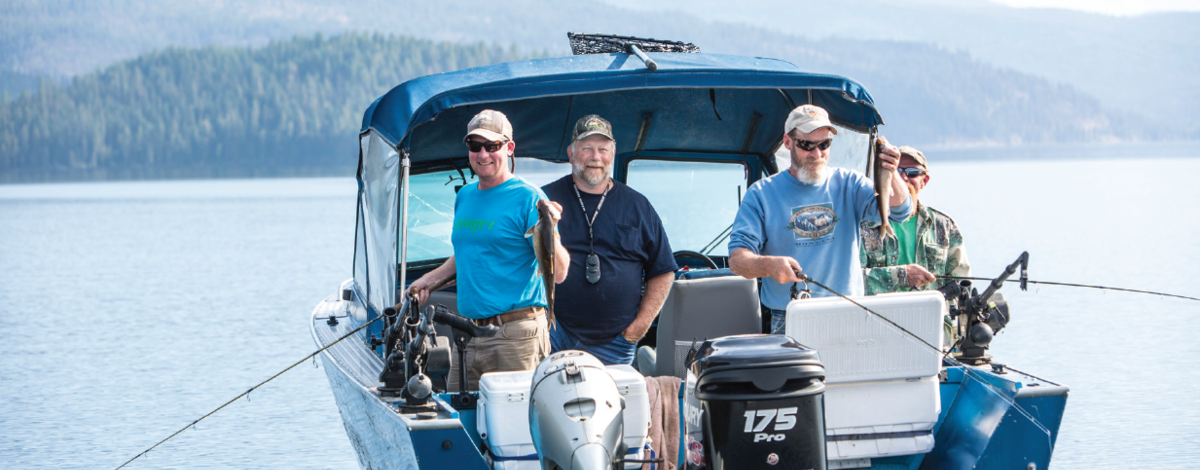Lake trout were one of many non-native fish species sprinkled throughout the American west in the 1920’s by the US Fish Commission. Shipped from the Great Lakes Region by railroad, the intent was to provide fishing opportunity and food for growing rural communities. In the Idaho Panhandle, Priest Lake was one of the recipients of those introductions. Lake Trout were not instantly abundant in Priest Lake. In fact, they existed at rather low densities until the 1970s. But they’ve since become the most abundant sport fish in the lake.
As lake trout abundance grew, it negatively influenced other fish populations. The fisheries for kokanee, cutthroat trout, and bull trout eventually faded in Priest Lake. Since the late 1970s, lake trout angling has dominated Priest Lake and presently they offer excellent fishing. Priest Lake is managed primarily to provide opportunity to catch and harvest lake trout. The daily bag limit is six fish with no size restrictions.
Lake Trout fishing on Priest Lake tends to be fairly predictable and savvy anglers can expect to catch good numbers of 15 to 25 inch fish. Generally, lake trout fishing is good year round, but peak catch rates typically occur in early spring and late fall. Regardless of season, most successful anglers use one of two techniques—trolling or jigging. Lake Trout are usually closely associated with the bottom and are typically found in depths between 100 and 200 ft.
Although average catch rates are high, trophy-size lake trout are fairly uncommon these days. The reason is lake trout simply don’t grow as fast as they once did. Abundant kokanee are the key to growing big lake trout. After lake trout predation caused kokanee to collapse in the 1970s, their formerly abundant food source went away and average lake trout size declined. Most lake trout now feed primarily on mysis shrimp (a small freshwater shrimp) and never reach trophy size. While lake trout may not grow as fast anymore, their mysis-rich diet produces bright-orange filets that are highly desirable table fare for many anglers.
Priest Lake provides a great opportunity to catch and harvest lake trout, which keeps many anglers quite satisfied. But, not all anglers agree that it’s the best management option. Some anglers recall the days when kokanee and cutthroat trout dominated the fishery and would prefer to see it that way again. Other anglers would prefer to catch more large lake trout. Because multiple opinions exist about how to best manage Priest Lake, the Idaho Department of Fish and Game (IDFG) is asking the public “what kind of fishery do you want?”
To help answer this question, IDFG has been working with local stakeholders to develop options for future management of Priest and Upper Priest lakes. Three alternatives were recently developed by the stakeholder group for broader public input. One option is to maintain the existing fishery, which favors lake trout in the main lake. Another is focused on enhancing kokanee, cutthroat trout, and bull trout, which requires managing against lake trout. Yet another and even more challenging alternative would attempt to strike a balance by reducing lake trout in Priest Lake somewhat with the intent of allowing other species to increase moderately. Upper Priest Lake management would continue to focus on native fish conservation under each of these options. All options have unique benefits and challenges that anglers will need to consider.
Public meetings will be held to discuss Priest and Upper Priest Lake management options in detail and solicit input from the public. The first public meeting is scheduled for Thursday, July 13th at 6:30 PM. The meeting will be held at the Inn at Priest Lake in Coolin. Another meeting is scheduled for Monday, July 24th at 6:30 PM in Priest River. The meeting will be held at the Priest River Events Center. Finally, a meeting is scheduled for Thursday, July 27th at 6:30 PM in Coeur d’Alene. The meeting will be held at the IDFG Panhandle Regional Office. Interested parties are encouraged to attend.

